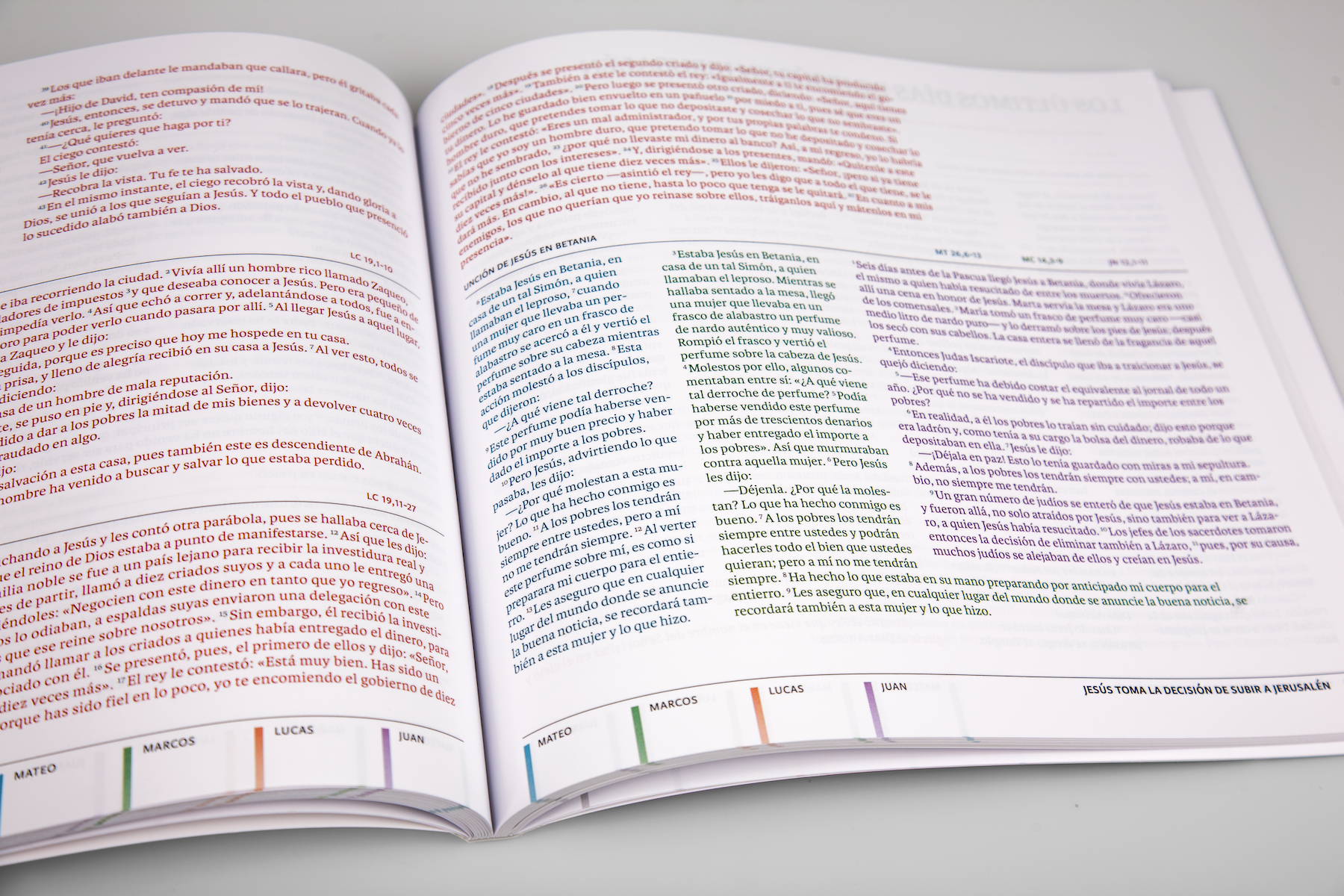Chronological Synoptic Gospels
A synchronoptical interview
When 2K/ develops Bible concepts, we find our inspiration in trying to solve real problems.
One of these potential problems is the feeling that new Bible readers get when they understand that the New Testament begins with four different variants of the same story – the life of Jesus Christ. What they describe is the same, but their perspectives differ. But how do these compare? Which one should I read? Should I read them all?
More seasoned Bible readers could have questions along the same lines: How do I get to read about all the events in the life of Jesus, without reading all the four Gospels one at a time? Or how do I know what parts Mark left out of his Gospel, now that it is so much shorter than the others?
Our answer to questions like these is the Chronological Synoptic Gospel – a parallel synoptic setting of the four Gospel texts arranged chronologically. This Bible concept has so far been published in English, Spanish, and Dutch with more to come. But why don’t we let the first three publishers provide their individual take on this concept? What they describe is the same, but their perspectives differ.
LifeWay Christian Resources’ CSB Christ Chronological, published 2017.
José Luis Albares, Editorial Verbo Divino:
Daniëlle de Gelder, Bible Society of the Netherlands:
Trevin Wax & Chris Cowan, LifeWay Christian Resources:
Which problems does the Chronological synoptic gospels solve?
As synoptic, reading La vida de Jesucristo…
helps to capture the similarities and differences between the four evangelists (and the diversity of their theological perspectives) when it comes to presenting the scenes of Jesus’s life and their respective contexts.
promote the specific understanding of each evangelist as their respective peculiarities are clearly presented; both what they say and what they keep silent on.
reinforces the idea of plurality or symphony (the Quadriform gospel) that is a characteristic of the biblical tradition and the Christian faith.
As chronological, reading La vida de Jesucristo …
offers a comprehensive understanding of the entire Jesus story, from his prehistory "together with God" (John 1:1-2, page 1) until his ascension "together with God" (Mark 16:19, page 127).
places the stories of Jesus and the Church in indissoluble continuity.
provides a practical way out – without claiming to settle the question categorically – regarding the classic problem about the links between the three synoptic gospels (Matthew, Mark, Luke) and the Gospel of John.
helps to understand that narrativity is an essential element of biblical and Christian faith. This narrative identity of the faith requires a continuous and continued reading of the Gospels, a reading that will avoid the problem of texts -simply ringing in the memory of the believer.
A lot of Bible readers know that the four gospels tell a lot of the same stories. They would like to compare these stories and broaden their knowledge of Jesus’ life. They might not even know about the existence of publications where the gospels are presented synoptically, because these publications are usually not very accessible for non-theologians. This is where Het leven van Jezus Christus – de vier evangeliën naast elkaar come into the picture. It presents the gospels synoptically, while the use of colors makes it very accessible to a lot of people. All the stories that can be compared are placed next to each other, which makes this book very easy to use.
The four Gospels tell the one story of the life and ministry of Jesus Christ. They include his deeds and teachings, and they culminate in his death, burial, and resurrection. In their presentation, there is much overlap of material. But therein lies the problem. The Gospels are not exactly the same. Though Matthew, Mark, and Luke—the “Synoptic Gospels”—share much of the same material, John is different in much of its content. Even among the three Synoptic Gospels, there are notable differences in wording and chronology of events.
CSB Christ Chronological places the four Gospels in parallel format and organizes them according to the same chronology. This permits the reader to compare the same teaching or events across the Gospels and easily view the similarities and differences. In addition, each page includes brief commentary to explain the differences based on the perspectives and emphases of the authors—each of whom composed a work combining history, literature, and theology. The “problems” that arise as a result of variations in content and chronology do not call the integrity of Matthew, Mark, Luke, and John into question. Rather they reflect the intentions and purposes of each as an author. CSB Christ Chronological not only answers common questions but also highlights the perspective of each Gospel and its witness to the mission of Jesus Christ.
Compared to traditional presentations of the Gospels, what are the benefits of this publication?
Only through the synoptic-chronological, joint and continuous reading of the four Gospels can we fully contemplate the true face of Christ. In the traditional presentation (individual reading of a single gospel), the reader only perceives a single perspective – limited, therefore – of the total mystery of Jesus, of his works and words.
In Het leven van Jezus Christus the story of Jesus’ life is very clear. When an event in Jesus’ life has been told by more than one of the evangelists these stories are placed side by side. Every evangelist has his own color, so that it is always clear who wrote what.
We have added some study material helping the reader to make thorough comparisons between passages from different gospels that tell the story of the same event. This makes Het leven van Jezus Christus a book that people can actually use, without being distracted by a lot of very specific information that is only interesting for theologians.
Though other products exist that present the Gospels in parallel format, the CSB Christ Chronological is unique in that the text of each Gospel is presented in a different color and in chronological order. Moreover, the commentary notes offer explanations not available in other Gospel parallels. Thus, readers benefit from both presentation and information.
Which target groups do you envision for it in your market?
Without a doubt, La vida de Jesucristo will be very valuable for priests, pastors, catechists, leaders of Christian groups, teachers and teachers in religious education.
It will also be a discovery for believers already initiated in the reading of the Bible, since they will be able to undertake a much deeper reading of the Gospels.
And any reader interested in learning about the figure of Jesus at first hand will find an unbeatable tool in La vida de Jesucristo.
We envision that this publication will be attractive for active Bible readers who are very familiar with the bible, but who want to take it to the next level. Another target group are people, who are in a Bible study group in their church and want to discuss the gospels in depth.
Christians who long to see more of the distinctive shape and form of each Gospel account of Jesus will appreciate this resource. It will aid them in appreciating the distinctive voices of each Gospel writer when you see how each portrait is both similar and yet still different from the others.
How and to what degree does creative presentation and design positively impact the appeal within these groups?
Beyond its undoubted aesthetic value, the design of this presentation (in colors and columns) is, above all, significantly useful, since it helps at all times to be located diachronically (the columns are developing the chronological plot of the story) and synchronously (the colors help identify at all times the details of the evangelist who is narrating a certain event).
Comparable publications are made for professional readers such as theologians or ministers (pastors). They look like a school book. The creative presentation and design makes this publication accessible to a lot more people. It makes it a book that attracts their attention in the bookstore and opens a new way of Bible reading to them.
Design is massively important for this process. It is what aids the reader in seeing the Gospels laid out this way and the appeal of the presentation is what will draw people into deeper reading and study of the Gospels. Without that creative element, this kind of approach could begin to feel very clinical and academic. The colorful design invites someone to read and drill down into the beauty of the four Gospels.
How would you describe a relevant and approachable Bible publication for the future?
Contextualized specifically for your audience (children, youth, families, elders, pilgrims, prayerful people, students, priests, specialists, etc.)
Dynamic in its graphic design
Elegant
Interactive, that is, facilitating real exchange (interaction) in groups
Interesting from the perspective of the life of faith and the actuality of life
Manageable in terms of its physical size, that is, “usable” (easily transportable, easily manually manipulatable, all pages are easily opened)
Academic foundation, even if generally approachable on the surface
At the Bible Society of the Netherlands we are always looking for new ways to help people experience the relevance of the Bible. We try to make the Bible as approachable as it can be, both by creating content to help people of all ages understand the Bible better and by making it accessible in new and interesting ways. A relevant and approachable Bible publication should offer the reader a package in which they find everything they need to get going: text from the Bible, short explanations about the cultural historic background of the Bible and applications for everyday life. We make products that have all that, like our Family Bible or Bible within reach.
A relevant and approachable Bible needs to match a beautiful, inviting design with a biblical translation that communicates truth well in a contemporary world. The variety of Bibles on the market today can be a source of wisdom and inspiration as people encounter the Word of God in its transformative beauty.
José Luis Albares
Editorial Verbo Divino
Has a degree in Biblical Sciences from the Pontifical Biblical Institute of Rome and is currently working as editor of Biblical Projects at the prestigious Verbo Divino publishing house (Spain). His professional centre of interest is especially focused on the teaching of the Bible, that is, to try to communicate the Word of God in an effective and affective way to all Christian believers and all people who want to know the deep biblical foundations of Western culture.
Daniëlle de Gelder
Bible Society of the Netherlands
Works for the Bible Society of the Netherlands. She serves as an editor and – together with her colleagues – her ambition is to create books that make the Bible come alive for people.
Trevin Wax & Chris Cowan
LifeWay Christian Resources
Chris Cowan serves as Editor for Bibles and Reference Books at LifeWay Christian Resources. He received his Ph.D. in New Testament from the Southern Baptist Theological Seminary.
Trevin Wax earned his Ph.D in Theology at Southeastern Seminary in Wake Forest, NC, and his Masters of Divinity at Southern Seminary in Louisville, KY. He now serves as a Bible and Reference Publisher for LifeWay Christian Resources. He lives in middle Tennessee with his wife, Corina, and their three children
Verbo Divino’s La Vida de Jesucristo, published 2018.
The Dutch version, Het leven van Jezus Christus, is currently being printed and scheduled for release spring 2019.








